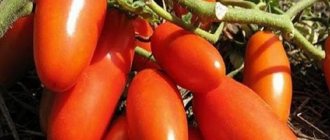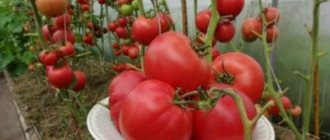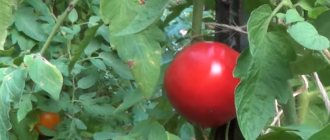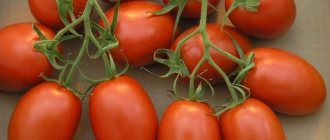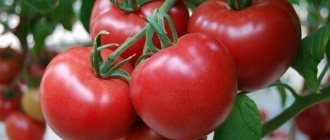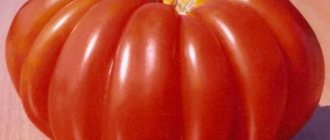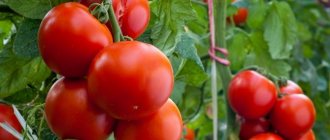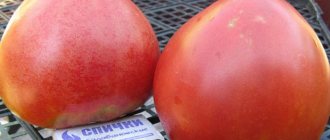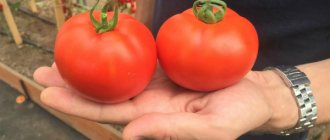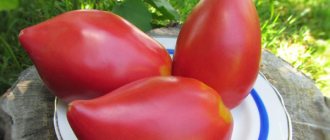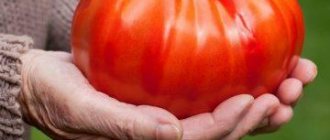Description of tomato Stick
The Palka tomato variety was developed in the United States in 1958. In other catalogs it is found under the names:
- Curl tomato;
- Curly leaf tomato;
- Stick tomato;
- Terry tomato.
The Palka tomato variety belongs to the category of semi-determinate and mid-season. About 110-120 days pass from the moment the shoots emerge until the tomatoes begin to ripen. Plants can be cultivated both in greenhouse conditions and in open ground.
Tomato bushes are columnar, with small, highly corrugated foliage. There are relatively few leaves, they are arranged in bunches. Several thickened vertical shoots are formed on one plant. In a greenhouse they grow up to 160 cm in height; in open areas the stems are significantly lower. The plant will need to be fixed to a support during cultivation. Tomato inflorescences are racemose, simple, shortened, containing up to 5-6 fruits. According to the description of the Palka tomato variety, under suitable weather and climatic conditions, 4-5 clusters are formed on each shoot.
Features of the variety
Palka tomatoes differ from the usual varieties of tomatoes in the non-standard structure of the bush. The long stem, reminiscent of a column, is devoid of leaves and side shoots. The height of the plant can reach 1.5 m. The leaves are small and form a bunch.
The fruits are located on tassels coming directly from the stem. 5-6 fruits grow on one inflorescence. With good care, you can harvest up to 1.5 kg of harvest from 1 bush.
Description of the bush
The semi-determinate tomato Stick forms a thick, but fragile, slightly pubescent erect stem, from which sparse vertical stepsons extend. For the most part, they are located below the first fruit cluster and must be removed. Left without a garter, the upper side shoots become bent and spread out.
The plant height declared by the seed manufacturer is 160-180 cm. In practice, in open ground, even with good care, most bushes do not always reach 120-130 cm.
But the main feature of Stick is the leaves. They are corrugated, twisted into a “rose” (see photo), with a petiole so short that they seem stuck to the shoots. The leaves do not shade the bush and give the plant an exotic look.
Description of fruits
Tomatoes of the Stick variety are compact, regularly round in shape, fleshy, and elastic to the touch. During the ripening process, the fruits are colored light greenish; upon reaching the ripe stage, they acquire a bright red color. Weight varies from 50 to 100 grams. The taste is good, typical of tomatoes, with a slight sourness. Tomatoes are covered with a dense skin that is not prone to cracking, even if the fruits are overripe.
Fruit characteristics
In theory, tomatoes should be round and red, weighing up to 100 g. But here, depending on your luck. When growing seeds from one packet you can get the following fruits:
- red;
- yellow;
- orange-brick;
- purple;
- green.
The roundest tomatoes are usually red, the rest often have 4 faint edges indicating chambers. But the size of the fruit rarely reaches 100 g; 40-50 g can be considered average.
The exception is green Stick tomatoes. The reviews about them are the best - a tall, strong bush, good yield in the first season, large, tasty tomatoes that last almost until the New Year.
Tomatoes are collected in bunches of 4-7 pieces. The pulp is very dense. The taste of the fruit is pleasant, classic sweet and sour.
Basic qualities of fruits
tomato stick in the photo
The fruits are round, dense, red in color at maturity, weighing 50-100 grams, fleshy, good tomato taste with sourness. Not prone to cracking, the skin on the fruit is dense. These tomatoes are ideal for canning, but are quite tasty fresh.
Productivity of the Stick tomato: 1-1.5 kg of fruit from 1 plant (subject to agricultural practices).
In other catalogs, this tomato may be called Curly-leaved, Double-leaved, Stick tomato, Curl tomato.
Area of application of fruits
Stick tomatoes are the best option for canning, but tomatoes can also be eaten fresh. They are often used to prepare various salads and other dishes.
Features of the view
Characteristics and description of the variety:
| Tomato | |
| general characteristics | Mid-season |
| Maturation period | 110-120 days after germination |
| Keeping quality (safety in storage) | Low |
| Purpose | Salad, canning (for processing into juices and sauces) |
| Fruit weight | 50-100g |
| Number of fruits per cluster | 4-5 |
| Disease resistance | High |
- The Stick tomato was introduced in the USA in 1958. Found under other names: Curl tomato, Stick tomato. Designed for cultivation in open and closed ground.
- The plant is semi-determinate. The bushes are columnar, up to 160 cm high. The leaves are small, wrinkled, collected in bunches. One flower cluster bears up to 6 fruits. The trunk is fragile and needs to be tied up.
- In terms of ripening time, it is mid-season: the first ripe tomatoes appear 110-120 days after germination.
- The fruits are bright red, round in shape. Fleshy, with thick skin, sweet, with a slight sourness. The average weight of one tomato is 50-100 g.
- Ripe fruits do not crack and are stored for 2-3 weeks. They tolerate transportation well. A variety for universal use. Tomatoes are delicious fresh and prepared.
- Productivity is average. From one bush you can get up to 1.5 kg of tomatoes.
- Resistance to diseases is high.
To save space, tomatoes can be planted every 20 cm and planted in 1 trunk. Photo: 1.bp.blogspot.com
Characteristics of tomato Stick
The variety in question has practically no disadvantages. The only drawback is the weak and flimsy stem, which often breaks under the weight of its own fruits. To avoid this, plantings have to be tied up several times during the growing season.
Characteristics
Tomatoes (Palka variety) were bred by US agrobiologists in 1958. The description of plants of an unusual variety of tomatoes is associated with the memorable appearance of the bush. Stick columnar tomatoes are distinguished by a virtual absence of foliage.
The external description of the variety (photo below) confirms the exotic appearance of the plant. The leaves have a corrugated structure, are small in size, and are located close to the trunk of the plant.
This allows you to plant tomatoes at a distance of 20 cm from each other. The bush is of a semi-determinate type, 100-120 cm high, consists of several vertical stems, does not require the formation or removal of shoots.
Weak stems need additional support. In a simple cluster, 5-6 fruits of a regular, round shape are formed and ripen. The pulp is fleshy, dense, the taste is traditional tomato with a sour note. At the stage of technical ripeness, the fruits acquire a bright red color.
Tomatoes have a dense skin that is not prone to cracking when ripe. The weight of the fruit is 50-100 g. The yield of 1 bush is 1-1.5 kg. With normal planting density, 30 kg of tomatoes can be harvested from 1 m². The fruits are used fresh and for canning.
Tomato can be grown in open ground and in a greenhouse. Tomatoes of the Palka variety ripen in 3.5-4 months from the moment the seeds are planted. The tomato is resistant to many diseases of nightshade crops.
The variety is not a hybrid, so it is possible to collect seeds for sowing next season. To obtain seeds, select ripe tomatoes that ripen on the second bunch. The best seeds come from fruits that have a small depression at the bottom.
There is a variety with a consonant name, differing in the appearance of the bush and fruit. The old family tomato Opalka migrated at the beginning of the last century from Poland to the USA (New York).
The plant is characterized by a narrow type of foliage and an average ripening period. Tomatoes are up to 12 cm long, shaped like peppers. The weight of tomatoes reaches 200 g. The pulp contains few seeds. The fruits are used to make juice, paste, and puree.
Disease resistance
Tomato has shown high resistance to major crop diseases. This does not cancel preventive treatments.
Stick does not get rid of late blight. But the fungus affects it less than other varieties; if it reaches a critical stage, it does so by the end of the season.
Productivity
The variety is mid-season, colored fruits appear after germination in 110-120 days. Those who have planted Palka once often note that the bushes are weak and produce a meager harvest even with compact planting.
Indeed, in the first year there are few fruits on the tomato. But if you collect your own seeds and sow next season, the tomatoes will show greater yield. After 1-2 years, 1-1.5 kg per bush is collected. When planted in 1 trunk and the recommended planting pattern is 1 sq. m really gives 30 kg.
Productivity and fruiting
The productivity of the Palka tomato variety can reach up to 1-1.5 kg per individual bush or up to 30 kg per 1 m2. This indicator usually does not change depending on whether the variety in question is cultivated in greenhouse conditions or grows in open ground. Such productivity can be achieved only if all recommendations for agricultural cultivation techniques are followed.
Pros and cons of the variety
Advantages
Compared to popular tomato varieties, the Palka variety has many advantages:
- High-yielding variety - from 1 m² of bed you can get up to 30-32 kg of tomatoes;
- Compact placement - to accommodate 10 plants, a bed is required, the area of which is 1.5 times smaller than for placing bush varieties of tomatoes;
- Caring for plants of this variety is simple, even a novice vegetable grower can do it;
- The fruits are medium-sized, smooth and dense. They tolerate transportation well. Suitable for canning. They have a pleasant sweet and sour tomato taste.
Disadvantages of the variety
This variety has only one drawback - it has fragile long stems that can easily break under the weight of the fruit. To solve this problem, it is enough to tie the plant stems to a strong support.
Considering all the advantages of the Palka variety, it should be noted that such tomatoes will delight every gardener with the opportunity to grow a rich harvest in a small summer cottage. In addition, the exotic shape of tomato bushes will attract the attention of households and neighbors all summer. And seeds of a rare variety can bring additional benefits.
The main advantages of the variety: there are no side shoots at all, high yield, this variety does not require pinching, you can cook whatever your heart desires from these tomatoes.
In conclusion to this article, I would like to write that eating tomatoes is very beneficial for the body. Let growing your own tomatoes not only bring joy, but also benefit.
Varieties of tomato "Stick"
Tomato "Stick"
Until recently, the curly tomato "Stick" was represented by the only variety 'Stick' . The cultivar was obtained in the United States of America in 1958. Semi-determinate variety (50-120 centimeters) columnar in shape, ripening period 105-110 days after emergence. The color of the fruit is dark red, the average weight is 30-100 grams, the shape is round, the taste is sweet and sour.
Tomato "Blue Stick"
A new variety obtained in a Russian private seed farm based on the traditional American “Palka”. It differs from its predecessor mainly in the color of the fruit, since it has a dark purple “tan” in the upper part of the tomatoes. When grown in full sun, this shade becomes almost black. The shape of the fruit is round, weight 30-40 grams. Otherwise, the appearance of this tomato is identical to the classic “Stick”.
Tomato "Brown Stick"
Another exclusive variety from a Russian private seed farm. Individual fruits are larger than the classic variety and reach 150 grams. The main difference of the cultivar is its unusual color, which changes as the tomato ripens. In the technical ripeness phase, these tomatoes have a dark green color with streaks of yellow and purple colors. As they mature, they become more colorful, with brown, yellow, red and purple markings. Fully ripened fruits are brick red.
In addition, the variety has larger fruits compared to the red-fruited variety. The sweet and sour taste of tomatoes is complemented by wine notes, like chokeberry varieties of tomatoes.
Is it worth planting the “Stick” tomato?
Definitely worth it! But only as an exotic curiosity, which, no doubt, will cause strong emotions and many comments from guests and neighbors. A curly tomato will look very organic in a container arrangement in combination with several low-growing vegetables. In this case, placed in a patio or on a terrace, it will not only decorate the local area, but also allow you to enjoy the fruits without going into the garden.
Also, “lazy” or busy gardeners may pay attention to this tomato, since it requires less care compared to its rapidly growing counterparts, which need to be planted.
However, with regard to yield, here it, apparently, will not be able to compete with traditional fruits. Therefore, you should not rely on it too much. In any case, growing such an exotic plant will certainly bring pleasure to experienced gardeners who have seen many varieties of tomatoes, but most likely have not met anyone like it. Moreover, “Stick” will not take up much space in the garden bed and will not require special attention.
Perhaps the “Palka” tomato will have its loyal fans, because the low yield is compensated by the possibility of planting plants very close to each other. But, in my opinion, this is a “one season” variety, like many other exotic, but relatively low-yielding crops. Having played with a curiosity once, not everyone will want to give it a place in the garden again. First of all, we grow vegetables in order to obtain a bountiful harvest with high taste. In any case, that's what I think.
Advantages of the “Stick” tomato:
- extraordinary appearance, highly decorative;
- the ability to plant plants at very close distances;
- the fruits do not crack;
- there is no need to tear off the stepsons and foliage shading the fruits;
- is a variety, you can collect your own seeds;
- disease resistance;
- high transportability.
Disadvantages of the “Stick” tomato:
- low yield;
- average taste;
- slow growth compared to classic tomatoes;
- high “splitting” of offspring (plants with normal foliage can grow from seeds);
- very fragile thin stems that need to be tied up in several places in a timely manner.
And finally, I will “complain” to the readers that while I was growing my only “Stick”, I heard questions from neighbors many times: “What is wrong with your tomato and why haven’t you removed it from the garden yet?”
Advantages and disadvantages
- The tomatoes of the described variety have the following advantages:
- they are mid-season;
- they are easy to care for due to the absence of side shoots and large leaves;
- they are grown both in the garden and in the greenhouse;
- plants take up little space, so they can be planted densely;
- disease resistant;
- they can be stored for a long time;
- You can collect seeds from the fruits of this variety.
The “Palka” variety has only one drawback - the fragility of the stem.
To prevent tomatoes from breaking, they must be tied up several times. Did you know? In various sources you can find different names for this variety: Stick tomato, Curl tomato, Terry or Curly-leaved tomato.
Planting seedlings
To prepare the seeds, select the ripest and largest tomatoes of the Palka variety, characterized by its typical shape. Usually tomatoes that grow from the second tassel are used.
Important! It is recommended to use seed from female fruits that have a small depression on the underside of the tomato.
A small amount of potassium permanganate is diluted in a container with clean water so that the liquid becomes pink. It is used for washing the collected fruits for the purpose of disinfection and removal of pathogens. Next, the tomatoes are moved to an insulated room without lighting and left for 5 days. After the specified period of time, the fruits will become softer, after which they are cut in half using a previously disinfected knife. The contents of the tomatoes, along with the seeds and pulp, are carefully squeezed into a clean, deep bowl. It is covered with cotton cloth on top and placed in a dark room.
After two days, the contents of the container will begin to ferment. When a whitish thin film forms on the surface of the pulp and bubbles begin to appear, this will signal that the seed is ready for washing. At this time, the seeds themselves will sink to the bottom of the vessel. Pour clean warm water into a glass and carefully rinse the seeds. The procedure is repeated until the water becomes completely clear.
To rid the seeds of excess moisture, they are evenly laid out in a thin layer over the surface of a cotton cloth. After this, they are transferred to a sheet of white paper in one layer to dry. Soon the Palka tomato seeds will become free-flowing, they are poured into paper bags for storage.
Seeds should be planted for seedlings 60 days before transplanting to a permanent place, otherwise they will not have time to fully ripen. This is usually done in the first half of March. It is recommended to purchase special ready-made soil at a garden store and pour it into a container or box. Both the soil and the container are disinfected before sowing using a thick solution of potassium permanganate. The same liquid, as well as a 1% solution of boric acid, is used to disinfect seeds.
Several shallow grooves are made on the surface of the soil at a distance of 3 cm from each other. Seeds are placed in them every 1-1.5 cm, deepening them by 1 cm. Cover with a transparent film and place in a warm room (with a temperature of about +22...25C) for several days, during which the first shoots should form.
Features of cultivation, planting and care
these are the leaves of the Palka tomato
We recommend sowing the seeds of this tomato variety for seedlings 60-65 days before the intended planting in the ground. When planting seedlings of this tomato in a permanent place, thickened planting is allowed according to the following scheme: 40 x 20 cm. The bushes do not shade each other, everything is well ventilated - there are practically no leaves.
Further care for tomatoes is usual: weeding, timely watering, fertilizing with complex mineral fertilizers and prevention from diseases and pests.
You can see other interesting varieties of tomatoes in our selection of Rare varieties of tomatoes. Enjoy watching.
Features of transplanting into the ground
Planting of seedlings is carried out after the final completion of frosts and the establishment of stable sunny weather.
Before planting, it is necessary to loosen the soil well with the addition of compost and wood ash. The permissible distance for planting seedlings is 15 cm between bushes, if 1 sprout is planted. If 2 or 3 sprouts are planted in one hole, then the distance increases to 25-35 cm. The distance between rows is 0.5 m.
Such close proximity will not affect the quality of the crop, since the plant is well lit and ventilated due to the absence of leaves. You can plant up to 30 bushes per 1 m².
Deep planting is not recommended to avoid excessive development of the root system, which will delay the ripening time by 2 weeks.
Attention! Planting in the evening and cloudy days is more favorable for rooting of the sprout.
First, you need to fill the container or box with the seedlings with warm water and leave it to soak. This will help remove the grown seedlings without damaging the roots.
It is necessary to prepare the land for planting, select a suitable site according to the rotation rules. When rotating different crops, the following occurs:
- exchange of microscopic elements necessary for each plant;
- the plant kills its harmful microflora;
- pests that have buried themselves for the winter period, not finding their usual food in the spring, die;
- When plants consume some elements, they release others, thereby enriching the soil.
Fertilizer should be prepared for the soil. Compost, humus and the following solution can be used as fertilizer:
- 25 g superphosphate;
- 10 g ammonium nitrate;
- 15 g potassium chloride;
- 10 liters of water.
Plants in a greenhouse need feeding twice as much as in a garden. The table will help you understand mineral fertilizers.
| A drug | Purpose | Consumption rate | Methods of carrying out work |
| Master (green) | Root feeding | 0.35-0.40 g | Watering every week with a 0.2% solution |
| Megafol (biostimulant) | In stressful situations | 25-30 ml | Spraying under stress |
| Fitolavin-300 | Treatment of seeds before sowing, bacteriosis, powdery mildew | 20 g per kg of seeds | Spraying during the growing season with a 0.2% solution |
| Alirin-B, gamair | Root rot, powdery mildew | 20 tablets | Watering the soil |
| Zenkor, lapis lazuli | Weed control in open ground | 50 g per 10 liters of water | Soaking seeds before sowing in a 0.5% solution |
After applying fertilizers, the soil is dug up.
The procedure for planting in the ground:
- Make grooves of any length and width of 25-30 cm, the distance between them is not less than 0.4 m. The depth of the groove should be convenient for regular watering.
- Fill the grooves with water. Wait until the water is absorbed.
- Carefully, without damaging the root system, remove the seedlings one plant at a time from the box.
- Use a small spatula to make a small hole for the seedlings.
- Plant the seedlings in the hole. It is not necessary to bury the seedlings too deeply so that the forces of the young plant are directed toward growing upward and not toward developing an additional root system.
- The distance between the holes should not be less than 15 cm.
Planting scheme
When growing in 1 trunk, it is recommended to place tomatoes every 20-25 cm, leaving 40 cm between rows. Twisted sparse leaves do not shade the bush and allow the plants to ventilate.
You should not shorten the distance - during fruiting, the tomatoes will interfere with each other.
Subsequent care for tomatoes
Plants need to be irrigated every two days. The procedure is carried out in the evenings and water is poured under the root so as not to get on the foliage. Simultaneously with irrigation, it is recommended to loosen the soil in the bite sector to improve the access of moisture and air to the root system. At the same time, weeds are removed.
During the growing season, tomatoes of the Palka variety are fed twice. Before fruiting begins, prepare an aqueous solution from the following ingredients:
- 25 g superphosphate;
- 10 g ammonium nitrate;
- 15 g potassium chloride;
- 10 liters of water.
When fruiting begins, the following components are dissolved in 10 liters of water to feed tomatoes:
- 20 g each of potassium chloride and superphosphate;
- 15 g ammonium nitrate.
The plant cannot be planted, but it requires garters to support it. Without them, the stem risks breaking. To retain moisture in the bush sector and reduce the number of weeds, it is recommended to sprinkle the soil near the Palka bushes with mulch, which is used as leaf litter, peat or humus.
Watering
“Stick” tomatoes love moisture. They need to be watered generously every 2 days in dry weather. If it rains outside, water the plants less often (every 3-4 days).
Feeding
You can feed tomatoes at your discretion. It is good to use mineral fertilizers. For example, you can fertilize the soil immediately before planting seedlings. To do this, for 1 sq. m, 4 g of potassium, sodium and phosphorus are added to the ground.
You can use peat-compost mixture - you will need 4 kg per 1 sq. m. You can enhance the effect of fertilizing with the help of potassium and phosphorus (50 g each).
It is useful to water tomatoes 2 times a season with mineral fertilizers diluted in water. To do this, use 10 g of ammonium nitrate, 25 g of superphosphate and 15 g of potassium chloride per 10 liters of water.
Ash is considered a good fertilizer. It can also be sprinkled on the surface of the soil before planting seedlings.
Choose the fertilizing method depending on your own preferences.
Tying up a bush
Since the stems of these tomatoes are very fragile, they need to be tied up to prevent them from breaking. Tie the tomatoes with a thin and strong cord to a wooden or metal support buried in the ground near the bush. If necessary, you can tie it 2-3 times as the tomatoes grow.
Harvesting
Tomatoes begin to bear fruit 3.5–4 months after sowing. They can be stored for a long time in a cool, dark place. Tomatoes are consumed fresh and very often used for preservation. The fruits also tolerate transportation well due to their elastic skin.
As you can see, “Stick” tomatoes are quite easy to grow. Therefore, it is worth trying to grow this variety in the garden: if you follow the recommendations described above, you will definitely be satisfied with the results of your work.
Reviews
Among gardeners, the variety has extremely positive reviews. The Palka variety tomato, the photo of which is presented below, due to the absence of leaves and shoots, creates ease of care. The variety can be grown in ordinary beds.
Tomato connoisseurs note the taste of the tomato. Stick tomatoes, reviews and photos of which indicate stable yields, regardless of the place of cultivation, confirm the declared characteristics.
The tomato is characterized by stable fruiting. This quality is confirmed by numerous reviews from vegetable growers.
Pest and disease control
If agricultural cultivation techniques are not followed, the disease resistance of the Palka tomato variety can be significantly reduced. In this case, you will have to resort to the use of folk remedies or fungicidal preparations.
Not only the fight against harmful insects with the help of pesticides is practiced, but also the mechanical removal of pests from Palka tomatoes. The Colorado potato beetle, which is one of the most dangerous pests of tomatoes, can be collected by hand and crushed.
Pests, diseases
Compliance with the rules of agricultural technology will help reduce the incidence of plant diseases; traditional methods and fungicides show high efficiency. In addition to poisons, mechanical removal of beetles from tomatoes is also widely used; the Colorado potato beetle can be easily removed by hand.
I’ve been growing the Columnar Palka variety for three years now, the tomatoes are delicious, they’ve never gotten sick. The harvest is always good, but we managed to harvest more tomatoes in the greenhouse. Tomatoes have a sweetish taste and children love them very much.
A neighbor recommended the variety last spring and planted it this year. I didn’t do any stepsoning, which didn’t have any effect. I collected one and a half kilograms from one bush, all the fruits were intact, without cracks or stains. I plan to plant them further, especially since there is not much space.
The variety is excellent for greenhouses, as I have been convinced of more than once. The neighbors in the garden were interested at first, but now they grow it themselves. I plant the seeds at a distance of 18 cm, almost all the fruits ripen on the branch, a few ripen at home.
Preparing your seeds
As noted in the characteristics of the Palka tomato, this is a variety, not a hybrid. Therefore, it is possible to prepare your own seeds for the next season. Gardeners often ask about how to prepare them, because it’s no secret that seeds in stores are not cheap. And the quality of seed material does not always satisfy gardeners.
Own seeds of a particular variety retain quality. The tomatoes grown correspond to the description and characteristics.
Important! Tomato seeds do not lose their viability for 5 years.
Stages of work:
- To obtain seeds, you need to select ripe fruits that match the shape of the variety. As a rule, the fruits are picked from the second cluster. The best seeds come from so-called female tomatoes: there is a small depression on the bottom of the fruit.
- The tomato should be washed with warm pink water, dissolving potassium permanganate, to remove possible pathogens. For 5 days, the tomatoes are left indoors in a dark and warm place to ripen.
- When the tomato softens a little, cut it with a sterile knife and squeeze out the contents with pulp and seeds into a clean glass, cover with a piece of cotton cloth and leave in a dark place.
Even if there is not enough juice, it is forbidden to add water, otherwise the seeds will die.
- In two days the contents will begin to ferment. You can tell that the seeds are ready for washing by the thin film on the surface and bubbles. The seeds themselves will end up at the bottom.
- Pour warm water into a glass and carefully rinse the seeds. The procedure is repeated until the water becomes clear.
- The seeds are placed on a cotton cloth to remove moisture. Then they are laid out on white paper in one layer to dry.
- When the seeds become flowable, they are poured into paper bags. To avoid confusion, each of them is marked.
Attention! Seeds should be stored in a dry, dark place.
